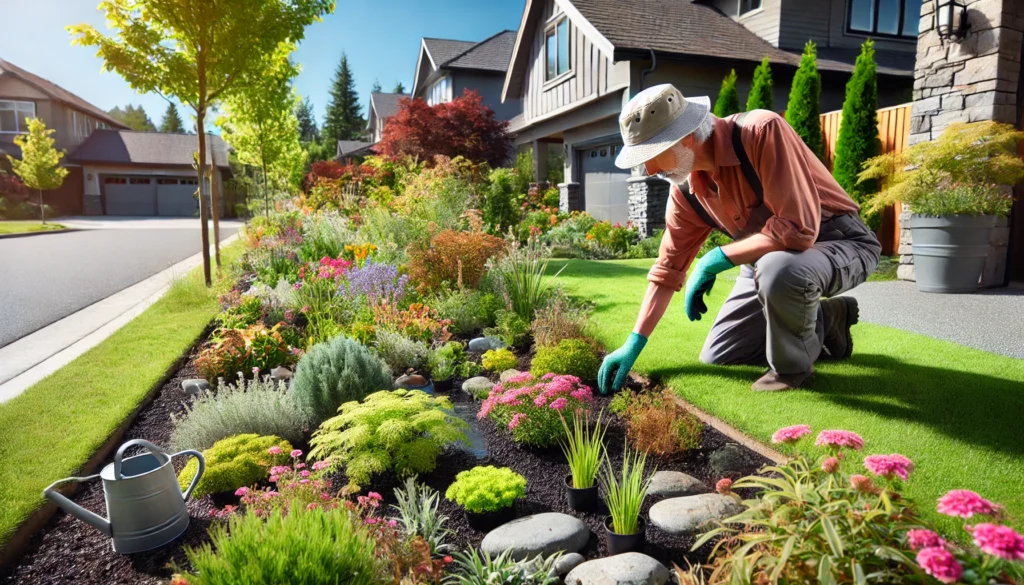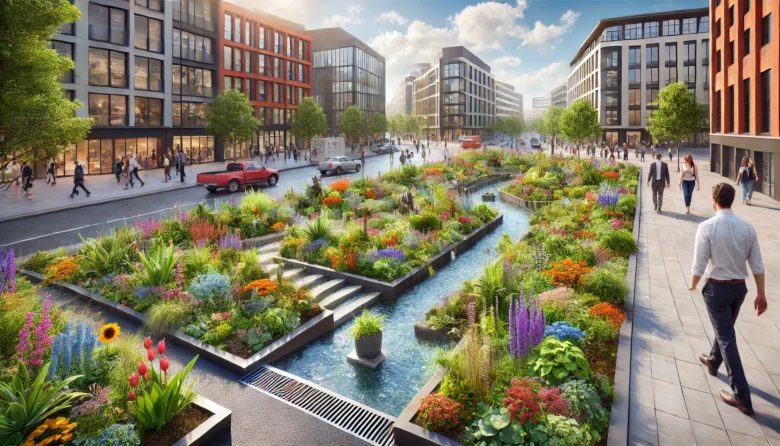Have you ever noticed puddles and streams of water flowing through the streets after a heavy rain? This water, often filled with pollutants, is known as urban runoff. Managing this runoff is crucial for maintaining healthy cities and ecosystems in a rapidly urbanizing country like India. Enter the rain garden—a simple, beautiful, and effective solution. Let’s explore how rain gardens can help manage urban runoff naturally.
What is a Rain Garden?
A rain garden is a shallow, landscaped depression that absorbs rainwater runoff from impervious surfaces like roofs, driveways, and streets. It is planted with native vegetation that helps filter and soak up water, reducing pollution and flooding. Rain gardens manage water and add beauty and biodiversity to urban spaces.
Why Rain Gardens Matter in India
India’s urban areas are expanding rapidly, leading to increased concrete surfaces and decreased natural land. This change has significant implications for water management. Traditional drainage systems often fail to handle heavy rains, leading to flooding and waterlogging. Rain gardens offer a natural and sustainable way to manage this problem.

Benefits of Rain Gardens:
Reduces Flooding: By absorbing rainwater, rain gardens reduce the volume and speed of runoff, helping prevent urban flooding.
Improves Water Quality: Plants and soil in rain gardens filter pollutants from the runoff, improving groundwater quality.
Enhances Aesthetics: Rain gardens add greenery and beauty to urban landscapes, creating pleasant and healthy environments.
Supports Biodiversity: Native plants attract birds, butterflies, and other wildlife, enhancing urban biodiversity.
Promotes Groundwater Recharge: By allowing water to seep into the ground, rain gardens help replenish groundwater supplies.
How to Create a Rain Garden
Creating a rain garden is simpler than you might think. Here are the basic steps:
Select a Site: Choose a low-lying area where water naturally flows or accumulates, such as near downspouts or driveways’ end.
Test the Soil: Ensure the soil can absorb water by conducting a percolation test. Dig a hole, fill it with water, and see how long it drains.
Design the Garden: Plan your rain garden’s shape, size, and depth. It should be large enough to capture and absorb runoff from surrounding areas.
Choose Native Plants: Select plants that are native to your region. These plants are adapted to local conditions and require less maintenance.
Prepare the Site: Dig out the garden area, create a shallow basin, and amend the soil with compost to improve drainage and fertility.
Plant and Mulch: Plant your chosen vegetation and cover the soil with mulch to retain moisture and reduce weed growth.
Maintain the Garden: Water the plants until established, and periodically remove weeds and debris.
Successful Rain Garden Projects in India
Bangalore’s Rain Gardens: Bangalore has implemented rain gardens in several public parks to manage stormwater runoff and reduce flooding. These gardens have improved the city’s water quality and green spaces.
Delhi’s Public Spaces: In Delhi, rain gardens are being integrated into public spaces like parks and playgrounds, providing educational opportunities for sustainable water management and creating beautiful urban oases.
Challenges and Solutions
While rain gardens offer numerous benefits, they also come with challenges:
Awareness and Education: Many must know about rain gardens and their benefits. Public awareness campaigns and educational programs can help spread knowledge and encourage adoption.
Space Constraints: Urban areas often have limited space. Creative designs and integrating rain gardens into existing green spaces can overcome this challenge.
Maintenance: Like any garden, rain gardens require maintenance. Community involvement and volunteer programs can help ensure their upkeep.
How Rain Gardens Can Benefit Indian Cities
Rain gardens can play a pivotal role in sustainable urban development in cities across India. They offer a natural solution to water management problems, enhance urban green spaces, and support local ecosystems. We can create more resilient and beautiful urban environments by incorporating rain gardens into city planning and individual properties.
Conclusion
Rain gardens are a practical and elegant solution for managing urban runoff naturally. They offer numerous benefits for cities in India by reducing flooding, improving water quality, and enhancing urban green spaces. As more people learn about and implement rain gardens, we can look forward to healthier, more sustainable urban environments.
Author’s Note
Thank you for exploring the world of rain gardens with me. If you found this blog informative and inspiring, please share it with others interested in sustainable living. Together, we can positively impact our cities and the environment.
G.C., Ecosociosphere contributor.
References and Further Reading:
- The Rainwater Harvesting (RWH) Network
- Centre for Science and Environment (CSE)
- Show Me Rain Gardens :: Home. https://showmeraingardens.org/forgot
- Sometimes Starting Over is the Best Option. https://www.ecosystemgardening.com/sometimes-starting-over-is-the-best-option.html
- A Guide to Easy Garden Maintenance | Beetham Nurseries. https://www.beethamnurseries.co.uk/news/291/a-guide-to-easy-garden-maintenance
- Scam Alert: Fake Brand Ambassador Managers Influence Peddling – Macaubiz. https://macaubiz.net/scam-alert-fake-brand-ambassador-managers-influence-peddling/
- Delridge Wetland Park – DNDA – Delridge Neighborhoods Development Association. https://dnda.org/dnda-nature/wetlands/




